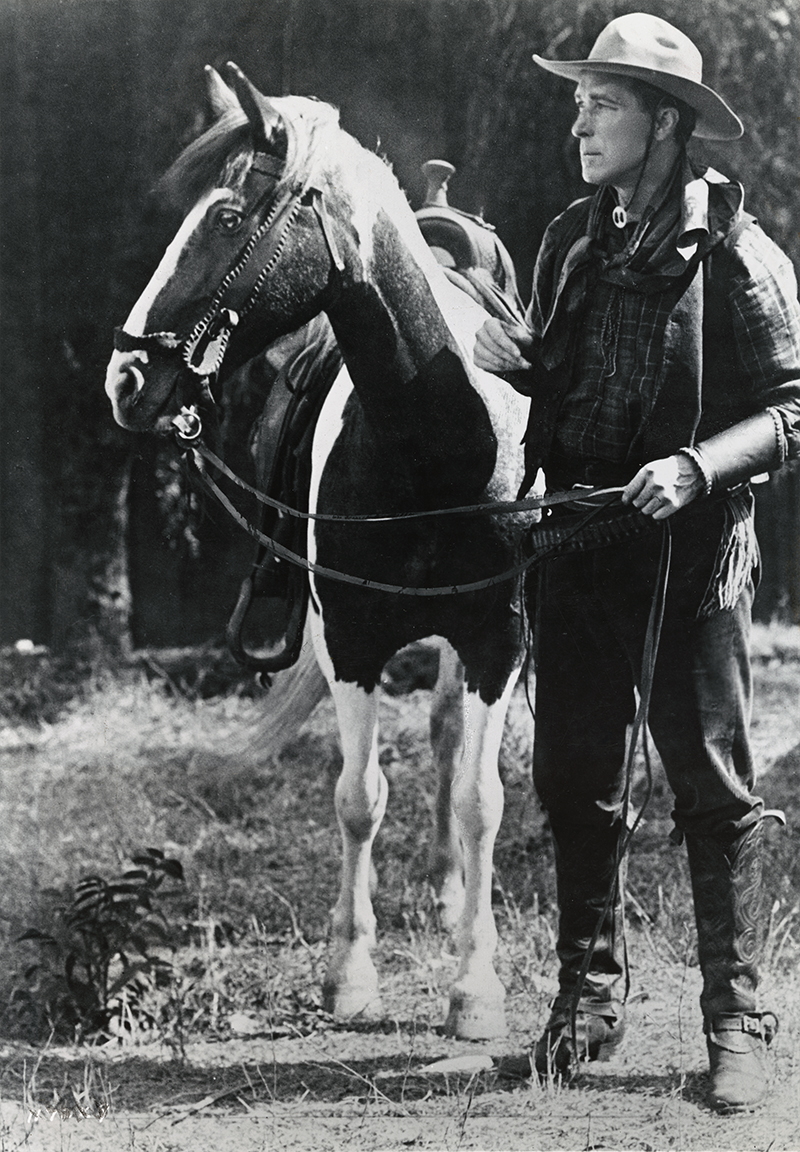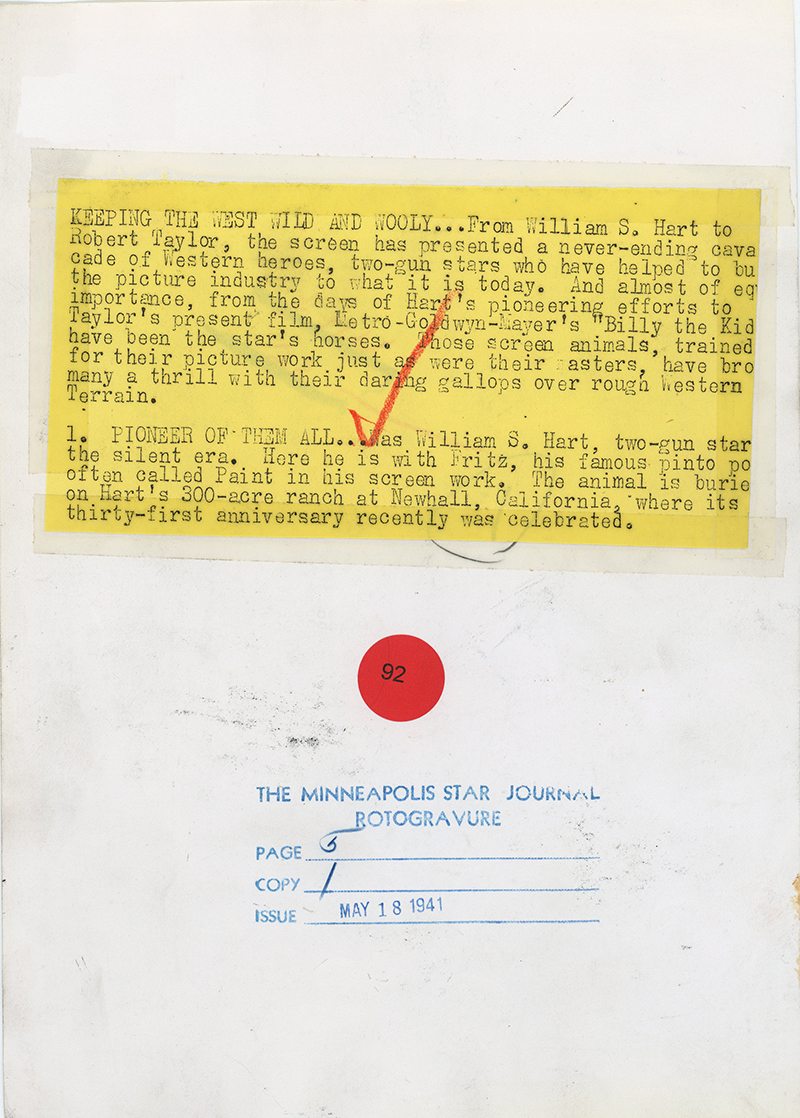|
|


Click image to enlarge
| Download archival scan
The 1941 photo shoot with actor Robert Taylor at William S. Hart's Horseshoe Ranch in Newhall included the redistribution of this earlier file photo of Hart and his pinto pony, Fritz, probably from the early 1920s. (Fritz died in 1938 at age 31.) 8x10-inch photo cut to 6½x9¾ inches; serial number at lower left has been blotted out on the original print from which this copy print was made. Photo editor's enhancements are also evident on Fritz's left foreleg; the enhancements are on the original print. This copy print is from the Minneapolis Star Journal archive. 1941 cutline reads (see below):
KEEPING THE WEST WILD AND WOOLY
From William S. Hart to Robert Taylor, the screen ahs presented a never-ending cavalcade of Western heroes, two-gun stars who have helped to build the picture industry to what it is today. And almostd of equal importance, from the days of Hart's pioneering efforts to Taylor's present film, Metro-Goldwyn-Mayer's "Billy the Kid," have been the star's horses. Those screen animals, trained for their picture work just as were their masters, have brought many a thrill with their daring gallops over rough Western terrain. 1. PIONEER OF THEM ALL... was William S. Hart, two-gun star of the silent era. Here he is with Fritz, his famous pinto pony, often called Paint in his screen work. The animal is buried on Hart's 300-acre ranch at Newhall, California, where its thirty-first anniversary recently was celebrated. The ranch is said to date to 1910 when its owner was George Babcock Smith.
William S. Hart
Biography by Friends of Hart Park
When William S. Hart began his film career in 1914, he initiated a fresh approach to Westerns that continues to influence the genre today. Although Western motion pictures were already very popular, for the most part they were exercises in mediocrity, filled with "impossibilities or libels on the West," according to Hart in his 1929 autobiography, My Life East and West. But in the course of appearing in or producing more than 60 movies over an eleven-year span, William S. Hart created a film style that revealed a more authentic vision of the Old West. At the same time, he made a major contribution to film history by developing and embodying the prototype of the frontier hero. Fame, artistic recognition, and wealth were Hart's rewards.
A Childhood in the West
William Surrey Hart was born in Newburgh, New York, probably in 1864. During his boyhood, his family traveled extensively in the Midwest as his father searched unsuccessfully for the ideal site to build a gristmill and make a permanent home for his family. Young Bill was raised in a pioneer atmosphere; he had contact with Indians, ranchers, and cowboys and learned Indian sign language and a little of the Sioux language from his playmates. He gained a respect for Indians and their cultures that he never lost.
Hart's First Career
The Hart family returned to New York while Bill was in his early teens, and it was there that he developed an interest in the stage. By 1900 he had appeared in productions from New York to San Francisco to Montreal. He received critical acclaim for his own production of The Man in the Iron Mask and his creation of the role of Messala in Ben Hur. Hart's first Western role was also in a stage production: in 1905, he was cast as "Cash" Hawkins in The Squaw Man. His subsequent stage roles were primarily Western and included the lead in an enormously successful production of The Virginian.
Two Gun Bill
While touring with the company of The Trail of the Lonesome Pine in 1914, Hart decided to move to California to make Western films. In his autobiography, he wrote, "I was an actor and I know the West. ... I had to bend every endeavor to get a chance to make Western motion pictures." Hart obtained parts in several Westerns and collaborated in writing screenplays, and his film career was launched. As a filmmaker, Hart drew on his childhood experiences, insisting on using realistic costumes, locales, and situation. The public loved "Two Gun Bill" and his movies, and he obliged the fans with one success after another. He became one of Hollywood's top actors and most successful directors.
La Loma del los Vientos
Some of Hart's Westerns were shot on and around a ranch in Newhall, California. In 1921[1] he purchased the property from Babcock Smith. After completing Tumbleweeds (1925), his final film and one of his finest, Hart commissioned Los Angeles architect Arthur Kelly to design a magnifient Spanish colonial-style mansion, which Hart christened La Loma de los Vientos (Hill of the Winds) and occupied in 1927. Hart filled his home with treasure reflecting his interest in the West, including Navajo textiles, Indian costumes, guns and weapons, and Western paintings and sculptures. In his retirement, he became active in the operation of his ranch and deeply involved in Santa Clarita Valley community affairs. He wrote more than a dozen novels and short stories as well as his fascinating autobiography, My Life East and West. Hart's reputation as a Western figure put him in contact with other prominent personalities of the day. Western enthusiasts, such as Will Rogers and Wyatt Earp, and important artists, including Charles M. Russell, C. C. Crisadoro, and James Montgomery Flagg, visited the ranch or corresponded with Hart.
The Hart Legacy
True to the spirit of Western heroes he had portrayed on screen, Hart was humbly grateful to the fans who had supported his film career. "While I was making pictures, the people gave me their nickels, dimes, and quarters. When I am gone, I want them to have my home." When he died in 1946, he left the bulk of his estate to the County of Los Angeles, stipulating that his house and the ranch property were to be used as a museum and public park. Today, the Parks and Recreation Department of Los Angeles County operates and maintains William S. Hart Park, which includes hiking and nature trails, a large picnic area, a campground, an exhibit of farm machinery, an assortment of live animals including a herd of bison, and approximately 110 acres set aside as a wilderness area. The Natural History Museum of Los Angles County is responsible for the interpretation of the historical portion of Hart's bequest, which includes his home and its contents and several other buildings. The Friends of Hart Park and Museum, an active group of local citizens, provides volunteer support services. La Loma de los Vientos stands today not only as a tribute to William S. Hart but as a valuable and edifying museum. Hart's personal effects and movie paraphernalia are displayed in his home along with Indian artifacts and Western American art that he amassed. These materials form a major resource for understanding the American West as it was perceived in the early part of the century. 1. Note: Original piece from Friends of Hart Park said 1925. Hart biography ©Friends of Hart Park • Used by permission.
LW3430: 9600 dpi jpeg from original photograph purchased 2017 or 2018 by Leon Worden.
|
1910s
1910s
1910s
~1915
Photoplay Cover 1916
Canadian Tobacco Card 1916
3/4 Body 1910s
Pre-1919
Color Strip 1919
Color Strip ~1919
Sheet Music: "I Want a Cave Man" 1919
1910s-1920s
Paramount 1910s-1920s
Australian Pinback 1910s/1920s
Arcade Card ~1920
~1920
O'Malley/Mounted 1921
Hart-Fritz 1920s
1920s
1920s
France 1920s
Germany 1920s
Spain 1920s
Spain 1920s
English Tobacco Card 1921
German Tobacco Card w/ Maurice Chevalier ~1920s
France 1920s
France 1920s
1920s
Cine-Mundial, Spain 1922
Tobacco Card
South Africa 1922
Flagg's KisselKar 1924
~1925
Shriners 1925
With Chief Standing Bear 1926
Arcade Card ~1926
4-Up Arcade Card 1928
Arcade Cards 1920s x2
|
The site owner makes no assertions as to ownership of any original copyrights to digitized images. However, these images are intended for Personal or Research use only. Any other kind of use, including but not limited to commercial or scholarly publication in any medium or format, public exhibition, or use online or in a web site, may be subject to additional restrictions including but not limited to the copyrights held by parties other than the site owner. USERS ARE SOLELY RESPONSIBLE for determining the existence of such rights and for obtaining any permissions and/or paying associated fees necessary for the proposed use.









































